Last Updated on April 9, 2025 by web manager
THE STAINED GLASS WINDOWS OF SAINT PATRICK’S (2025)
Written by Father Joseph Sirba.
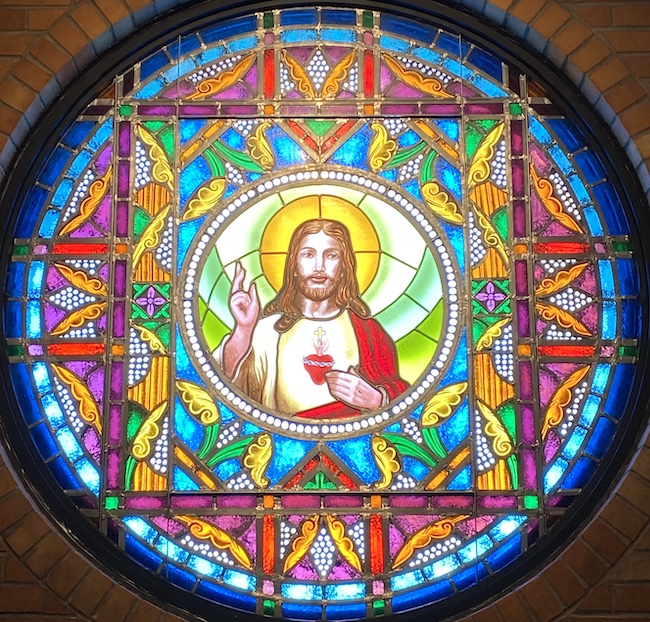
Stained glass windows were created to tell the story of our Catholic faith. This art developed in the 11th and 12th centuries along with gothic architecture which allowed large windows to be placed in churches. Since many people could not read, the windows became a kind of visual story of our faith. This tradition of stained glass continues here at Saint Patrick’s.
In our Church, most of our windows tell the story of the Rosary, and I would like to go through them with you now.
So, beginning on the south-east side of the Church, the first five windows symbolize the joyful Mysteries of the Rosary.
The first window has the Latin word “Ave” which means “Hail,” and it recalls the Angel Gabriel’s first word to Mary. The window also depicts the Holy Spirit coming down upon Mary and reminds us of when our Lady asked how she would conceive, the Angel said to her, “The Holy Spirit will come upon you, and the power of the Most High will overshadow you.” The lilies remind us of Mary’s purity.
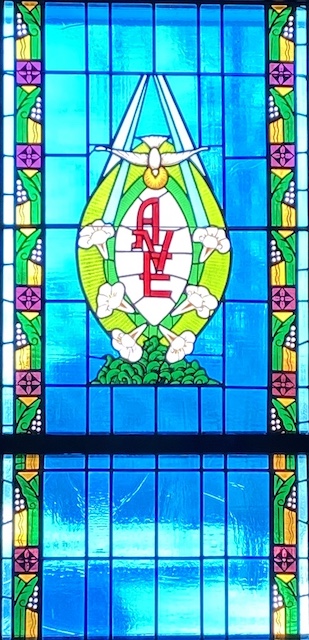
The next window pair (on the left) represents the Visitation. Here a path or road is depicted, and it recalls our Lady’s journey from Nazareth to her kinswomen Elizabeth who lived near Jerusalem. Notice that here the stem of lily (which represents Mary) is divided by the Chi-Rho symbol which represents Christ. This recalls that Mary is with child and reminds us of Saint Elizabeth’s greeting to Mary when she said, “Who am I that the Mother of my Lord should come to me?”
The window (on the right) represents the Nativity of our Lord. Here we see the manger filled with hay, and we see the Chi-Rho symbol for Christ above it. The star which the Magi followed is at the top of the window, and the two circles behind represent the Father and the Holy Spirit and the circle represents God who has no beginning and no end.

The next window pair (on the left) represents the Presentation where a sacrifice of two doves was offered for Jesus according to the law of Moses, something that was done 40 days after the birth of a male child. The light of the candle recalls the words of Simeon who said to Saint Joseph and the Blessed Virgin that the Child would be “a light for revelation to the Gentiles, and for glory to Your people Israel.”
The next window (on the right) represents the last of the Joyful Mysteries, the finding in the Temple. Here we see the two tablets on which the Ten Commandments were written by the finger of God. They represent the Law. The chair represents the place where one who teaches would sit, and it reminds us of how Jesus astounded the scribes with His teachings.
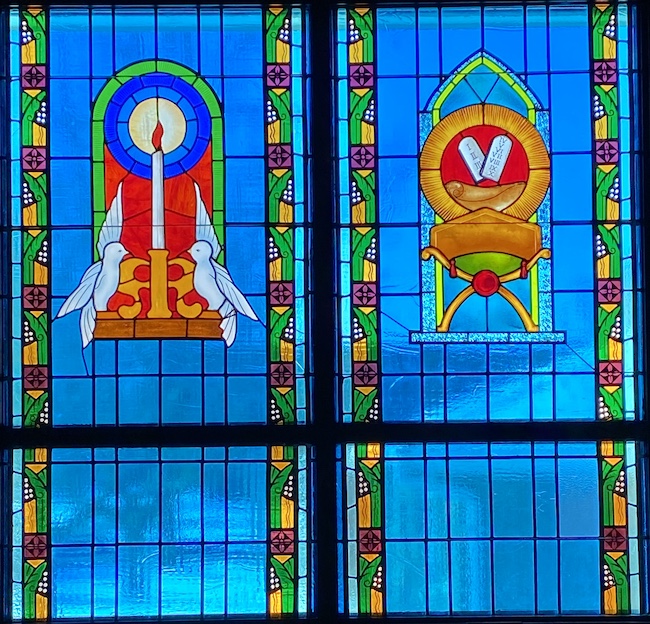
We now move west from the Joyful Mysteries to the Sorrowful Mysteries.
The next window pair (on the left) represents the Agony in the Garden. Here we see the chalice and recall the prayer of our Lord to His Father, “My Father, if it be possible, let this cup pass from me; nevertheless, not as I will, but as you will.” The cross foreshadows the sufferings which are soon to come. The red background also reminds us that Jesus’ suffering was so intense at this point that He sweated blood.
The next window (on the right) recalls the Scourging at the Pillar. Here we see the instrument of torture. There are also two Greek letters, Alpha and Omega, reminding us of the words of Jesus in Revelation, “I am the Alpha and Omega, the beginning and end of all things.”

We now go to the north side of the Church at the back and continue with the third Sorrowful Mystery.
The first window pair on the north side at the back of the church contains the 3rd and the 4th sorrowful mysteries.
In that first window pair (on the left) is the Crowning with Thorns. Here we see the thorns and also a red rectangle with lines through it symbolizing the blood flowing from our Lord’s wounds left by the scourging.
The next window (on the right) symbolizes the fourth sorrowful mystery, the Carrying of the Cross. Here again is the Chi-Rho symbol for Jesus. The cross is at an angle as if placed on our Lord’s shoulder.
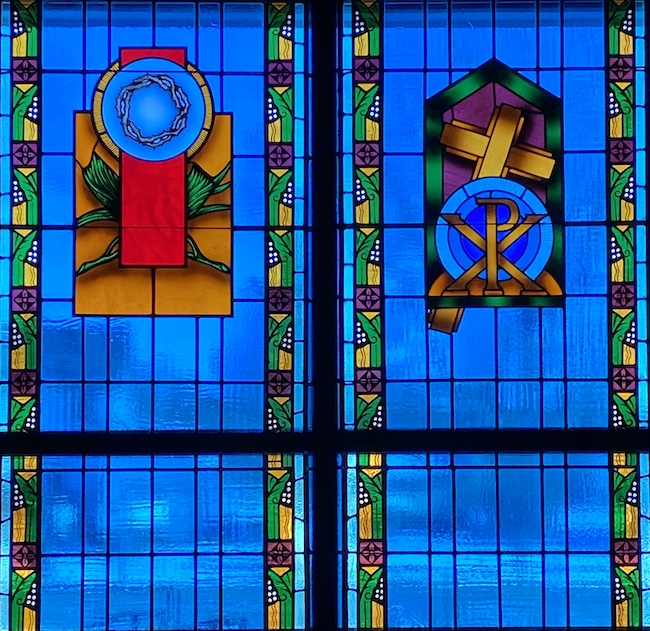
The next window pair towards the altar contains the 5th sorrowful mystery and the first Glorious mystery.
In that window pair (on the left) we see symbolized the Crucifixion and Death of Jesus. To the right and left of our Lord’s cross, there are two smaller crosses symbolizing the two thieves who died with our Lord. In the circle are the nails used to affix our Lord’s hands and feet to the cross and also once again the crown of thorns.
In that window pair (on the right) we turn to the Glorious Mysteries. First, there is the Resurrection. The two sets of wings symbolize the two angels who were present at the tomb when the holy women went there on that first Easter morning. There is a palm of victory and the Chi-Rho symbol upright to remind us that Jesus is alive.
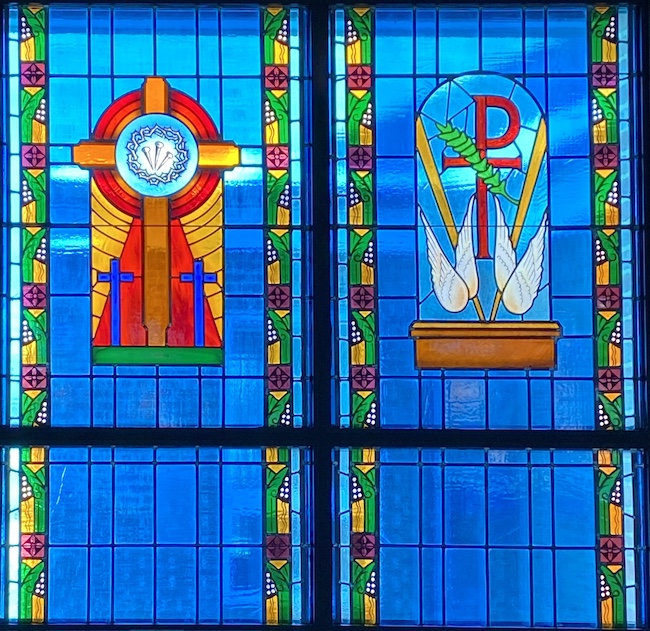
Now we have to jump to the Church Hall and walk to the left (north-west side) to continue.
When our Hall was built in 1999, because the church wall was demolished (where we now have glass windows/doors), the remaining six windows in that wall were moved into north side of the Hall. At that time, they were also put into new frames.
So the first window pair (on the left) in the Hall represents the Ascension of our Lord into heaven. Here we see clouds recalling that the Apostles continued to gaze up into the sky as Jesus ascended until He was obscured by the clouds. There is also the crown He now wears as King of Heaven and the scepter which He holds symbolizing His authority.
The next window (on the right) depicts the Descent of the Holy Spirit who is symbolized as a dove. The Holy Spirit is descending upon the Apostles on Pentecost. The tongues of fire remind us of how the Holy Spirit revealed Himself at this time.
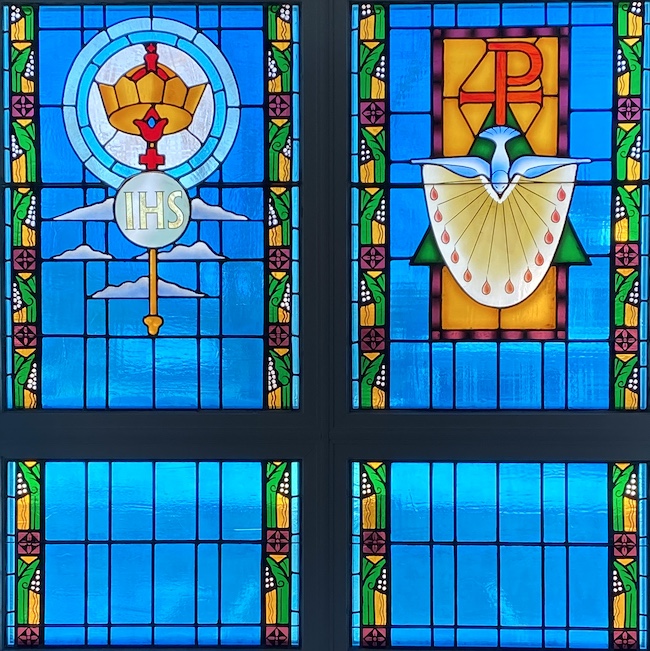
Moving towards the kitchen, the next window pair (on the left) in the Hall represents the Assumption of the Blessed Virgin Mary. Here we have clouds in the background symbolizing the sky and also wings symbolizing angels who carried our Lady to heaven. The crown symbolizes that she is Queen of Heaven.
The last glorious mystery is the Crowning of Mary Queen of heaven and earth. In this window are numerous symbols. The crown is prominent but there are also stars symbolizing the heavens. However, they also symbolize Mary. One of her titles is “Star of the Sea – in Latin, stella maris” and another “Morning star – stella matutinas.” We also see a triangle symbolizing the Holy Trinity and green symbolizing the verdant fruitfulness of the earth and the hills and mountains.
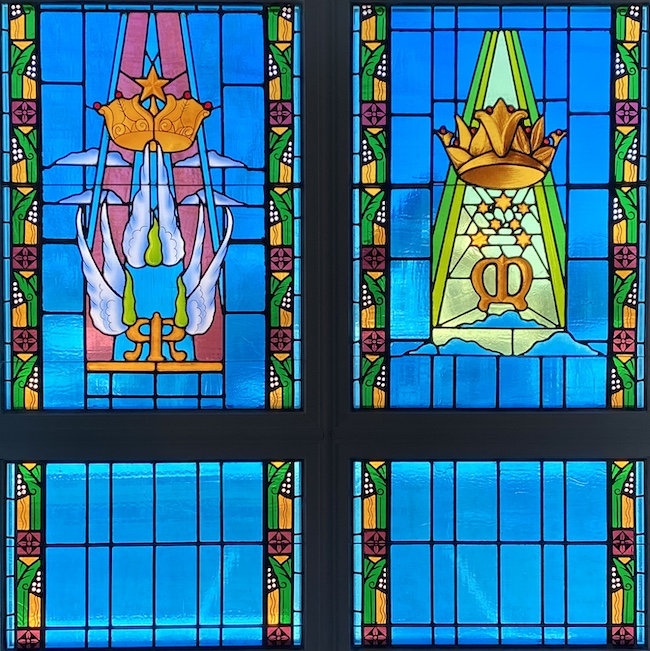
Moving towards the kitchen, again, are the last two windows in the hall.The First window (on the left) is dedicated to Saint Boniface (675 – 754), the patron saint of Germany. After a long career as a missionary, he was martyred in Frisia, an area located today on the border between Germany and Holland. Before he was killed, Saint Boniface held up a book of the Gospels to defend himself. This book is depicted pierced by a sword. The outline of a miter above the book reminds us that Saint Boniface was a bishop.
The Second window (on the right) would have been originally placed next to our Lady’s altar and is dedicated to Saint Therese of Lisieux (1873 – 1897). It depicts roses falling from the sky which remind us of the promise Saint Therese made to shower roses from heaven after her death. The green background in the shape of France, reminds us of her native country.
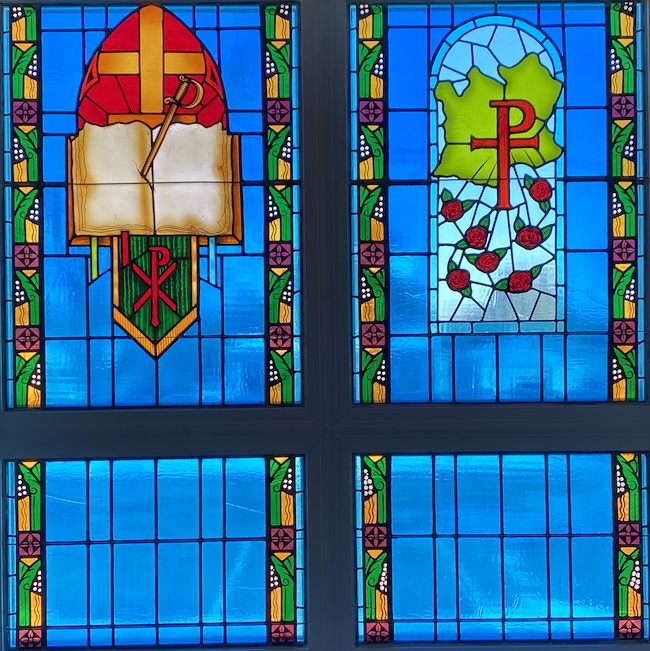
Notice in all of the windows, the border with grapes and wheat symbolizing the Holy Eucharist. The great act of worship in which we are presently engaged and the very reason for which our Church was built.
Finally, we have three more windows as we move to the back of the church.
Starting up the stairwell to the choir loft, this window symbolizes baptism. Before the reconciliation room was built, that space was the baptistry, and so, when the Church was new, this window (which now seems out of place) was right where it was supposed to be. It depicts the baptismal font and the Easter Candle symbolizing the light of Christ. It also has the Holy Spirit coming down and reminds us that just as the Holy Spirit descended upon Jesus when He was baptized, so too when we were baptized the Holy Spirit filled us with His gifts.
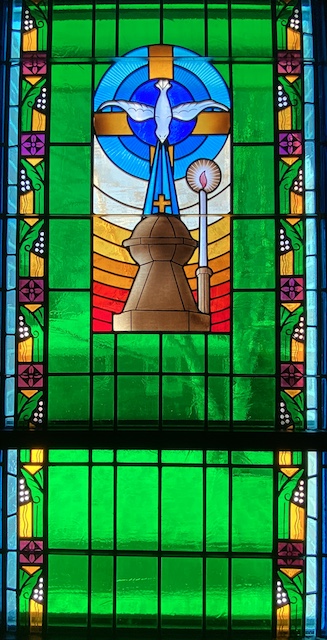
The window in the crying room symbolizes our Blessed Mother who gave birth to Jesus who stands behind and above her again symbolized by the Chi-Rho symbol. Beneath is the world which reminds us that Jesus is King the world and Mary its Queen. This window also reminds us of how our Lord and Lady watch over all mothers and their children, and of how they are pleased with a mother’s generosity and her openness to life.
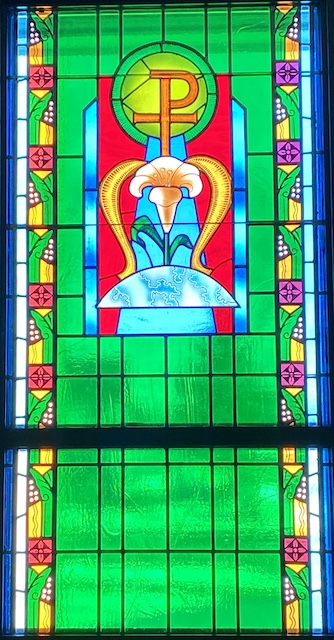
Our last and most beautiful and elaborate window is the rose window in the choir loft.
It’s called a rose window because of its circular shape. This window depicts the Sacred Heart of Jesus, and it reminds us of the great love our Lord has for us.

Our windows were ordered in August of 1954 from Saint Germain Brothers in Duluth. The cost at that time for all of the windows was $7,065. The original description of our windows written by Fr. Thomas McEnery (who was pastor) at the time reads as follows:
The Church of St. Patrick, Hinckley, Minnesota, has recently been embellished with a set of twenty stained-glass windows. Designed to carry out the Mysteries of the Holy Rosary, each window contains a unifying cobalt blue background and conventionalized side panelings depicting the Eucharistic theme. The symbolic portrayal of each mystery is meant to present the viewer with a simple, objective concept of one incident in the life of Christ and His Blessed Mother, and inspire him to further meditation upon that mystery. The main colors used – burnished gold, deep reds and greens, backed by an amber protective window, harmonize fittingly with the soft coral toned brick, blonded oak wood and buff and gold statuary in the church interior. Beside the fifteen mysteries of the Rosary, there are the main rose window containing the figure of the Sacred Heart, the Baptistry window, the window of Our Lady in the Mothers room, and those of St. Boniface and St. Therese of Lisieux, to inspire religious vocations.
Over the years, our windows have served to remind us of the mysteries of our holy Catholic faith. May we continue to be inspired by them to always seek a closer union with Christ our Lord.
